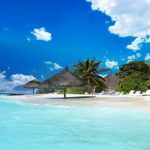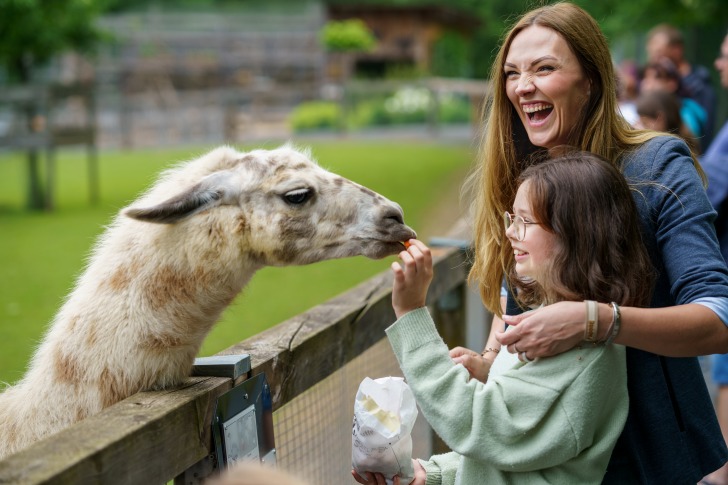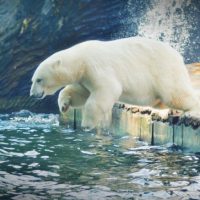Jamaica is the third largest island in the Caribbean.
With cities like Montego Bay and Kingston, it’s only logical that Jamaica is one of the most sought-after tropical destinations.
About 4.5 million people make their way out to the island nation each year to take in the weather and see some interesting sights.
There’s plenty of adventure to be had across the over 4,000 square miles that make up the country.
Here, we’re going to take a closer look at the best zoos and aquariums Jamaica has to offer.
Contents
6 Best Zoos & Aquariums in Jamaica
1. Jamaica Zoo
In the southeast town of Lacovia, there is a zoo that is the namesake of the country.
There is a wide range of exotic animals to see and some to feed.
Included in the ensemble are lions, zebras, crocodiles, monkeys, llamas, rabbits, and tucans.
We’re just getting started.
In total, there are 132 animals and 30 species.
There are so many big and little guys around that it would take a while to name them all.
The zoo is the first registered facility of its kind in the country and is currently owned by Paul Fearon.
He had the privilege of growing up around a bunch of animals thanks to his vet father.
As an adult, he continues to share his love of the fur kind with the natives and visitors of Jamaica.
Opened in 2010, it’s one of the only interactive exhibits with animals on the island.
Feeling a little rumble around the midsection?
There are several places to eat on the grounds and a large lawn to spread out on.
In the middle of a visit, there’s no better time or place to have some lunch.
This is also a good place to allow the little wild people in your group to get some of that energy out.
By the lawn is a playground with all kinds of equipment.
The zoo is ready to welcome interested patrons daily from 10 am to 6 pm.
2. Hope Botanical Garden and Zoo
Sitting conveniently in the capital city of Kingston, Hope Botanical Garden and Zoo is also referred to as the Royal Botanical Gardens.
This is a non-profit zoological garden as well as a wildlife rehabilitation center.
One of the most notable programs at Hope Zoo is about the critically endangered Jamaican Iguana.
Sprawled across 200 acres, this land has been set aside for animals since 1873.
It was part of the estate of Major Richard Hope.
He was the first to colonize the area by showing up with his own forces.
These days the land encompasses more than the garden once started by Hope.
The zoo is small but the botanical gardens come together to make time here very well spent.
It’s voted as one of the most peaceful places to go while in Jamaica.
Not only is there a petting zoo, but there is also a pavilion where big events and weddings are held.
What a backdrop!
Get out for a beautiful walk daily.
Hope Botanical Garden and Zoo opens as early as 6 am and closes at 6 pm.
It might be best to book a ticket in advance.
This is a great stop that many travelers go out of their way to see.
When planning, be sure to also check the calendar.
There are events for locals and beyond as often as monthly.
These events are a smart way of attracting visitors while providing something unique to do.
That’s just another good reason that Hope Botanical Garden and Zoo is one of the best places to visit on the island.
3. Jamaica Swamp Safari Village
In an effort to take care of the local crocodile population, the Jamaica Swamp Safari Village had humble beginnings back in 1969.
American Ross Heilman became quite fond of the area and decided to set up shop on the northern coast in Falmouth.
Before long, Heilman stepped outside of his croc comfort zone and started acquiring a variety of other animals.
That wasn’t the height of excitement around the village, however.
JSSV was featured in the 70s Bond film, Live and Let Die.
If you’ve seen the movie, you know the owner was a bit more involved than just his park being on display.
The real jewel, though, is being able to see crocodiles grow up, thanks to the wildlife sanctuary.
This is one of the only places where visitors can see each stage in the growth process, from hatchling to retirement.
The sanctuary crocodiles have helped keep the waters clean and balanced in the fish populations.
Learn something new about nature Wednesday through Sunday, from 9 am through 5 pm.
Be sure to plan ahead.
The last tour of the day begins at 4 pm.
4. Dolphin Cove
Many people talk about swimming with the dolphins, but this is where that can really happen.
There are five dolphin habitats on the northern coast.
The Montego Bay and Puerto Seco locations are the most popular coves, but they aren’t the only places.
If you want a less busy place, try Ocho Rios.
Reserving a swim package isn’t only for those who are on land.
If you’re on a cruise that will be stopping in Jamaica, dolphin swimming is an option for you, too.
Not only does your ticket help perpetuate the health and research of dolphins, it also buys you an amazing time with knowledgeable guides.
Dolphins aren’t the only thing to see in the cove.
There are also small local animals and a lush forest surrounds the grounds.
That means that just walking around will lead to something interesting to see.
Oh, let’s not forget the ability to swim with sharks and handle big birds!
If that sounds like a fulfilling time, be sure to book well in advance because everyone in the area wants to swim with dolphins.
5. Rocklands Bird Sanctuary
Being in the Caribbean, Jamaica has its fair share of breathtaking birds.
These birds are often bigger and brighter than the ones we’re used to seeing in the US.
Rocklands Bird Sanctuary not only wants to keep these birds safe and well-fed but they also go out of its way to educate the public.
Visitors who drop by have the opportunity to see some amazing tricks and get up close and personal.
Yes, feeding the birds is allowed, if not encouraged.
Part of the program is learning about the migratory patterns of birds all over the world and especially the ones in this neck of the ocean.
Along with learning about the avian creatures, there’s a garden where you can reflect on everything you saw while on the tour.
Find your new favorite sky flyer any day of the week from 10 am until 5 pm.
6. Black River Safari
If you’ve got 90 minutes to set aside while in Jamaica, the Black River Safari is an excursion you won’t want to miss.
A local guide takes you on a trip of wonder down the Black River, which exposes you to much of the fauna and flora of Jamaica.
What can you expect to feast your eyes on?
To start with, there are alligators, a variety of tropical birds, and a fleet of mangroves.
All of which are in their natural habitat.
The safari and cruise take place on 1,500 acres of protected wetlands.
Don’t feel uncomfortable with the famously dark river.
It only looks so dark because of the sediment.
The water itself is quite clear.
After seeing what’s going on outside, the grounds are also home to a sanctuary.
Ever held a baby crocodile?
You can inside.
Feel free to grab a bite to eat while you’re at it.
The food is so good that locals who aren’t on a safari cruise come by to eat, too.
Come by daily for food or fun between 9 am and 4 pm.
6 Best Zoos & Aquariums in Jamaica – Summary Table
| Zoos & Aquariums | Address |
|---|---|
| Jamaica Zoo | Lacovia, Jamaica |
| Hope Botanical Garden and Zoo | 231 Old Hope Road, Kingston, Jamaica |
| Jamaica Swamp Safari Village | F8RH+2R, Falmouth, Jamaica |
| Dolphin Cove | Belmont Road, Ocho Rios, Jamaica |
| Rocklands Bird Sanctuary | Rocklands Rd, Wiltshire, Jamaica |
| Black River Safari | 25F3+6F2, Black River, Jamaica |
Jamaica Safety Overview
READ THE FULL REPORT: Jamaica Safety Review
Safety Index:
- OVERALL RISK: MEDIUM
- TRANSPORT & TAXIS RISK: MEDIUM
- PICKPOCKETS RISK: MEDIUM
- NATURAL DISASTERS RISK: MEDIUM
- MUGGING RISK: MEDIUM
- TERRORISM RISK: LOW
- SCAMS RISK: MEDIUM
- WOMEN TRAVELERS RISK: MEDIUM
Frequently Asked Questions
Is Jamaica tourist-friendly?
Jamaica thrives off tourism.
Millions of tourists come from around the world every year just to dip their toes in the sand on Jamaican beaches.
Aside from the coast, there are rainforests and mountains to enjoy.
Don’t forget the cities!
Of course, it’s understandable for locals to get annoyed.
However, if they do, they don’t really let it show.
Jamaica is a safe place to visit, as long as travelers avoid areas known for criminal activity.
What's the most popular thing to do in Jamaica?
Tourists planning a trip to Jamaica almost always have at least one thing in common.
That thing is hitting up the beach, specifically.
Those who want to hang out at the most popular beach will head to Negril Beach, also known as Seven Mile Beach.
Along with the clean sand and clear water, the Negril Cliffs can be accessed here.
Negril Beach is often regarded as a top Caribbean beach.
Which city is the top Jamaican destination?
Travelers set their sights on Montego Bay more often than any other location around the island nation.
Not only is there a lot to do, such as going to the zoo, but there’s also a lot more set up specifically for tourists.
Let’s just say, Montego Bay is where the best beaches can be found.
This attention to detail is what attracts visitors with plenty to spend.
What language is spoken in Jamaica?
An English-speaking traveler would have no problem getting around or connecting with locals.
English is the official language of Jamaica.
However, locals also speak Jamaican Patois.
It is a language that is a derivative of Creole and includes English and African substrates.












The variety of animals and experiences at these zoos and aquariums make it a must-visit destination for any animal lover. I can’t wait to plan my trip and see all the incredible sights and creatures.